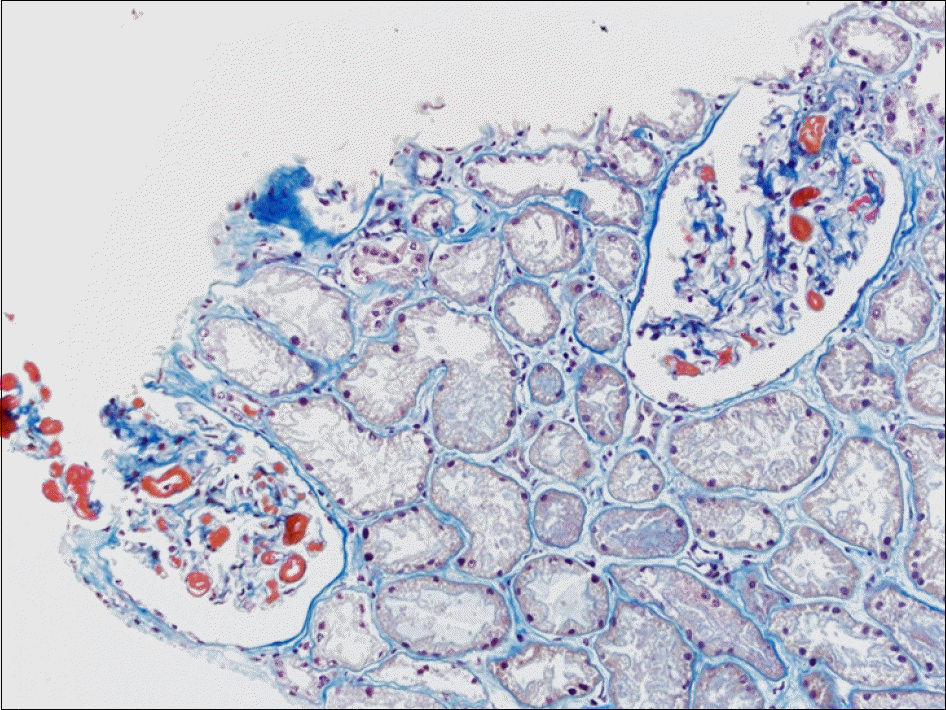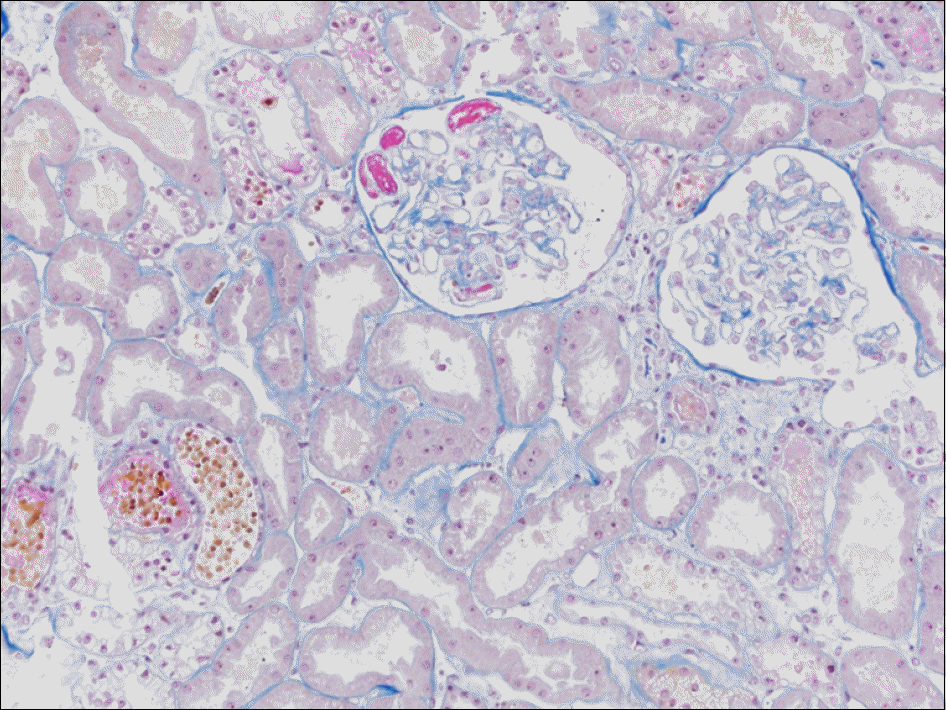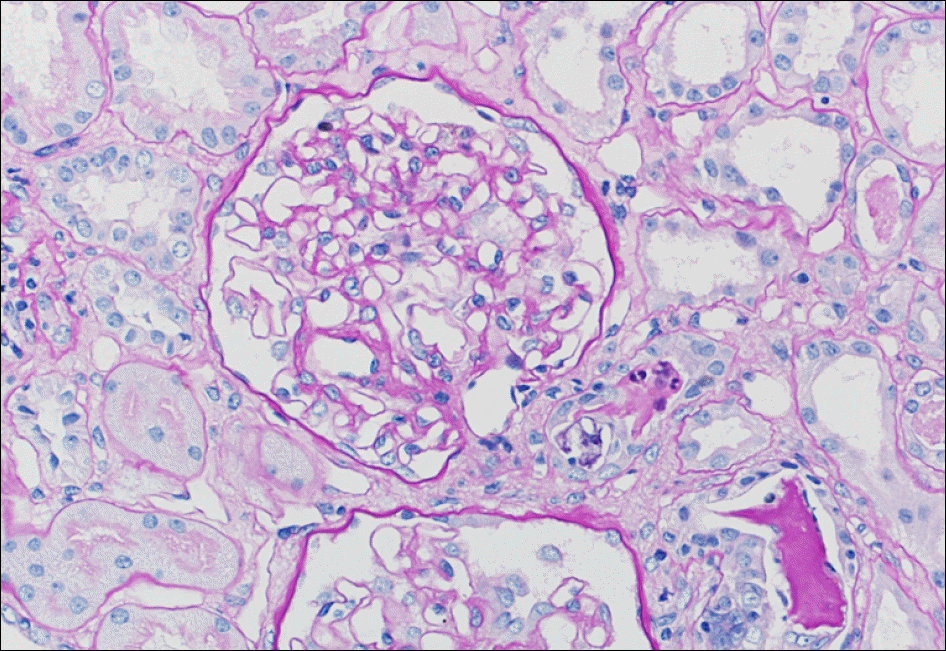Abstract
Microvascular thrombosis is an uncommon pathological finding in deceased donor kidneys. It is associated with disseminated intravascular coagulation (DIC) after brain injury in the donor. Although DIC in deceased kidney donors is known to have no association with graft outcome, microvascular thrombosis with DIC in a donor can cause renal graft impairment. For this reason, some transplantation centers do not accept these kidneys. A 39-year-old female donor had a subarachnoid hemorrhage. After a short period of cardiopulmonary resuscitation, we applied extracorporeal membrane oxygenation to maintain hemodynamic stability. The laboratory data were consistent with DIC. The recipient was a 38-year-old male patient who had been undergoing hemodialysis for 7 years because of end-stage renal disease of unknown cause. Zero-time graft biopsy revealed multiple intraluminal fibrin thrombi without peritubular capillaritis. Delayed graft function occurred after transplantation, and hemodialysis was started. Graft renal biopsy was performed on the third day after transplantation. The percentage of intraglomerular fibrin thrombi had decreased, and no significant peritubular capillaritis or C4d staining was observed. The function of the transplanted kidney started to recover, and hemodialysis was discontinued on the 10th day after surgery without specific treatment. Follow-up biopsy performed 20 days after the transplantation revealed normal kidney with completely resolved fibrin thrombi. We report herein a case of microvascular thrombosis in renal allograft from a DIC donor.
REFERENCES
1). McCall SJ., Tuttle-Newhall JE., Howell DN., Fields TA. Prognostic significance of microvascular thrombosis in donor kidney allograft biopsies. Transplantation. 2003. 75:1847–52.
2). Kang HR., Kwon SS., Yoon SY., Kim EN., Kwon SH., Jeon JS, et al. Treatment of presumptive BK nephropathy with ciprofloxain in kidney transplant recipients: three case reports. J Korean Soc Transplant. 2014. 28:254–8. (강혜란, 권성순, 윤석윤, 김은나, 권순효, 전진석, 등. Ciprofloxacin으로 치료한 BK 바이러스 관련 신장병증 3예. 대한이식학회지 2014;28: 254-8.).

3). Hefty TR., Cotterell LW., Fraser SC., Goodnight SH., Hatch TR. Disseminated intravascular coagulation in cadaveric organ donors. Incidence and effect on renal transplantation. Transplantation. 1993. 55:442–3.

4). Wang CJ., Shafique S., McCullagh J., Diederich DA., Winklhofer FT., Wetmore JB. Implications of donor disseminated intravascular coagulation on kidney allograft recipients. Clin J Am Soc Nephrol. 2011. 6:1160–7.

5). Pastural M., Barrou B., Delcourt A., Bitker MO., Ourahma S., Richard F. Successful kidney transplantation using organs from a donor with disseminated intravascular coagulation and impaired renal function: case report and review of the literature. Nephrol Dial Transplant. 2001. 16:412–5.

7). Wada T., Gando S., Mizugaki A., Yanagida Y., Jesmin S., Yokota H, et al. Coagulofibrinolytic changes in patients with disseminated intravascular coagulation associated with postcardiac arrest syndrome: fibrinolytic shutdown and insufficient activation of fibrinolysis lead to organ dysfunction. Thromb Res. 2013. 132:e64–9.

8). Zangrillo A., Landoni G., Biondi-Zoccai G., Greco M., Greco T., Frati G, et al. A meta-analysis of complications and mortality of extracorporeal membrane oxygenation. Crit Care Resusc. 2013. 15:172–8.
9). Plotz FB., van Oeveren W., Bartlett RH., Wildevuur CR. Blood activation during neonatal extracorporeal life support. J Thorac Cardiovasc Surg. 1993. 105:823–32.




 PDF
PDF ePub
ePub Citation
Citation Print
Print





 XML Download
XML Download